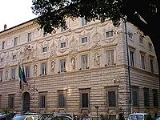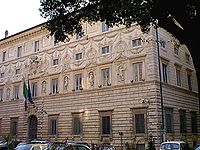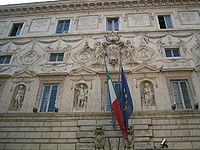
Palazzo Spada
Encyclopedia


Rome
Rome is the capital of Italy and the country's largest and most populated city and comune, with over 2.7 million residents in . The city is located in the central-western portion of the Italian Peninsula, on the Tiber River within the Lazio region of Italy.Rome's history spans two and a half...
, Italy. It is located in the rione
Rioni of Rome
A rione is an Italian term used since the Middle Ages to name the districts of Rome, according to the administrative divisions of that time. The word originates from the Latin word regio A rione (pl. rioni) is an Italian term used since the Middle Ages to name the districts of Rome, according to...
Regola
Regola (rione of Rome)
Regola is the VII rione of Rome. The name comes from Arenula, that was the name of the soft sand that the river Tiber left after the floods, and that built strands on the left bank...
, at Piazza Capo di Ferro, 13, very close to the Palazzo Farnese. It has a garden facing towards the River Tiber
Tiber
The Tiber is the third-longest river in Italy, rising in the Apennine Mountains in Emilia-Romagna and flowing through Umbria and Lazio to the Tyrrhenian Sea. It drains a basin estimated at...
.
The palace accommodates a large art collection, the Galleria Spada. The collection was originally assembled by Cardinal Bernardino Spada in the 17th century, by his brother Virgilio Spada and added to by his grandnephew Cardinal Fabrizio Spada
Fabrizio Spada
Fabrizio Spada was an Italian Cardinal of the Roman Catholic Church, and served as Secretary of State under Pope Innocent XII.-Life:...
,
History
It was originally built in 1540 for Cardinal Girolamo Capodiferro. Bartolomeo Baronino, of Casale MonferratoCasale Monferrato
Casale Monferrato, population 36,058, is a town and comune in the Piedmont region of north-west Italy, part of the province of Alessandria. It is situated about 60 km east of Turin on the right bank of the Po, where the river runs at the foot of the Montferrato hills. Beyond the river lies the...
, was the architect, while Giulio Mazzoni
Giulio Mazzoni
Giulio Mazzoni was an Italian painter and stuccoist, active during the Renaissance period. He was born in Piacenza, but studied in Rome under Daniele da Volterra, and was active about the year 1568. He helped decorate the Palazzo Spada. He also painted a canvas of the Four Evangelists for the...
and a team provided lavish stuccowork inside and out.
The palazzo was purchased by Cardinal Spada in 1632. He commissioned the Baroque
Baroque
The Baroque is a period and the style that used exaggerated motion and clear, easily interpreted detail to produce drama, tension, exuberance, and grandeur in sculpture, painting, literature, dance, and music...
architect Francesco Borromini
Francesco Borromini
Francesco Borromini, byname of Francesco Castelli was an architect from Ticino who, with his contemporaries, Gian Lorenzo Bernini and Pietro da Cortona, was a leading figure in the emergence of Roman Baroque architecture.A keen student of the architecture of Michelangelo and the ruins of...
to modify it for him, and it was Borromini who created the masterpiece of forced perspective
Forced perspective
Forced perspective is a technique that employs optical illusion to make an object appear farther away, closer, larger or smaller than it actually is. It is used primarily in photography, filmmaking and architecture...
optical illusion in the arcaded courtyard, in which diminishing rows of columns and a rising floor create the visual illusion of a gallery 37 meters long (it is 8 meters) with a lifesize sculpture at the end of the vista, in daylight beyond: the sculpture is 60 cm high. Borromini was aided in his perspective trick by a mathematician.
The Mannerist
Mannerism
Mannerism is a period of European art that emerged from the later years of the Italian High Renaissance around 1520. It lasted until about 1580 in Italy, when a more Baroque style began to replace it, but Northern Mannerism continued into the early 17th century throughout much of Europe...
stucco
Stucco
Stucco or render is a material made of an aggregate, a binder, and water. Stucco is applied wet and hardens to a very dense solid. It is used as decorative coating for walls and ceilings and as a sculptural and artistic material in architecture...
sculptural decor of the palazzo's front and its courtyard façades feature sculptures crowded into niches and fruit and flower swags, grotesches and vignettes of symbolic devices (impresi) in bas-relief among the small framed windows of a mezzanine
Mezzanine (architecture)
In architecture, a mezzanine or entresol is an intermediate floor between main floors of a building, and therefore typically not counted among the overall floors of a building. Often, a mezzanine is low-ceilinged and projects in the form of a balcony. The term is also used for the lowest balcony in...
, the richest cinquecento façades in Rome.

Julius Caesar
Gaius Julius Caesar was a Roman general and statesman and a distinguished writer of Latin prose. He played a critical role in the gradual transformation of the Roman Republic into the Roman Empire....
fell, was discovered under the party wall of two Roman houses in 1552: it was to be decapitated to satisfy the claims of both parties, which appalled Cardinal Capodiferro so, that he interceded on the sculpture's behalf with Pope Julius III
Pope Julius III
Pope Julius III , born Giovanni Maria Ciocchi del Monte, was Pope from 7 February 1550 to 1555....
, who purchased it and then gave it to the Cardinal.
Cardinal Spada's collection, which includes four galleries of 16th and 17th-century paintings by Andrea del Sarto
Andrea del Sarto
Andrea del Sarto was an Italian painter from Florence, whose career flourished during the High Renaissance and early Mannerism. Though highly regarded during his lifetime as an artist senza errori , his renown was eclipsed after his death by that of his contemporaries, Leonardo da Vinci,...
, Guido Reni
Guido Reni
Guido Reni was an Italian painter of high-Baroque style.-Biography:Born in Bologna into a family of musicians, Guido Reni was the son of Daniele Reni and Ginevra de’ Pozzi. As a child of nine, he was apprenticed under the Bolognese studio of Denis Calvaert. Soon after, he was joined in that...
, Titian
Titian
Tiziano Vecelli or Tiziano Vecellio Tiziano Vecelli or Tiziano Vecellio Tiziano Vecelli or Tiziano Vecellio (c. 1488/1490 – 27 August 1576 better known as Titian was an Italian painter, the most important member of the 16th-century Venetian school. He was born in Pieve di Cadore, near...
, Jan Brueghel the Elder
Jan Brueghel the Elder
Jan Brueghel the Elder was a Flemish painter, son of Pieter Bruegel the Elder and father of Jan Brueghel the Younger. Nicknamed "Velvet" Brueghel, "Flower" Brueghel, and "Paradise" Brueghel, of which the latter two were derived from his floral still lifes which were his favored subjects, while the...
, Guercino, Rubens, Dürer, Caravaggio, Domenichino, the Carracci
Annibale Carracci
Annibale Carracci was an Italian Baroque painter.-Early career:Annibale Carracci was born in Bologna, and in all likelihood first apprenticed within his family...
, Salvator Rosa
Salvator Rosa
Salvator Rosa was an Italian Baroque painter, poet and printmaker, active in Naples, Rome and Florence. As a painter, he is best known as an "unorthodox and extravagant" and a "perpetual rebel" proto-Romantic.-Early life:...
, Parmigianino
Parmigianino
Girolamo Francesco Maria Mazzola , also known as Francesco Mazzola or more commonly as Parmigianino or sometimes "Parmigiano", was an Italian Mannerist painter and printmaker active in Florence, Rome, Bologna, and his native city of Parma...
, Francesco Solimena
Francesco Solimena
Francesco Solimena was a prolific Italian painter of the Baroque era, one of an established family of painters and draughtsmen.-Biography:Francesco Solimena was born in Canale di Serino, near Avellino....
, Michelangelo Cerquozzi
Michelangelo Cerquozzi
Michelangelo Cerquozzi was an Italian Baroque painter.Born and active mainly in Rome, he is best known for small canvases of genre scenes, and for being one of the Italian proponents of the Bamboccianti style practised by a Dutch painter in Rome, Pieter van Laer...
, Pietro Testa
Pietro Testa
Pietro Testa was an Italian High Baroque artist, best known, both to his contemporaries and modern appreciation, as a printmaker and draftsman, who was active in Rome.-Biography:...
, Giambattista Gaulli, and Orazio
Orazio Gentileschi
Orazio Lomi Gentileschi was an Italian Baroque painter, one of more important painters influenced by Caravaggio...
and Artemisia Gentileschi
Artemisia Gentileschi
Artemisia Gentileschi was an Italian Early Baroque painter, today considered one of the most accomplished painters in the generation influenced by Caravaggio...
, has the additional interest of being hung in the 17th-century manner, frame-to-frame, with smaller pictures "skied" above larger ones.
Palazzo Spada was purchased by the Italian State in 1927 and today houses the Italian Council of State
Italian Council of State
The Consiglio di Stato is a legal-administrative consultative body and ensures the legality of public administration in Italy. The council has jurisdiction on acts of all administrative authorities, except when these authorities lack discretionary power, in which case the dispute is considered to...
, which meets in its richly frescoed and stuccoed rooms.
External links
- Official website
- Aerial photo - The Farnese is the large square palace at the left, while one block along the same street to the south-west is the smaller Palazzo Spada with its gardens facing the Tiber.
- Dido's Death, Guercino, commissioned from Guercino by Cardinal Spada, 1631, on behalf of Marie de Medici
- Video of Palazzo Spada
- Empire of the Eye: The Magic of Illusion: Palazzo Spada's Corridor, Part 5 (flash video)

